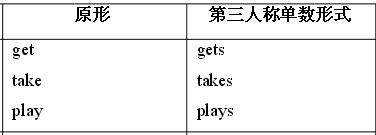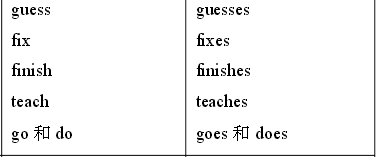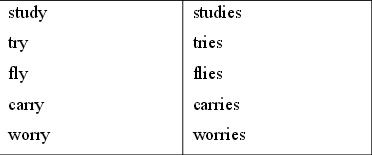动词第三人称单数的变化规则
1、1.一般情况下,直接在动词词尾+s,如下图:

2、2.以s, x, sh, ch, o结尾的动词,在词尾+ es,如下图:

3、3.以辅音字母+ y 结尾的动词,先把y变为i,再加es ,如下图:

4、4.不规则动词(特殊情况),如下图:

1、另外,在变否定句时候遵循以下规则:
含有动词第三人称单数形式的句子变否定句时,要在动词前面加上doesn’t 或does not,动词的第三人称单数形式要还原成原形:格式为doesn’t/does
not+ 动词原形,如:
He goes to school at six in the morning. (变否定句) 就变换为:
He doesn't go to school at six in the morning.
2、变一般疑问句:把含有动词第三人称单数形式的变成一般疑问句时,要借用助动
词does,如:
She goes home at five every day. (变疑问句)就变换为:
Does she go home at five every day?
--- Yes, she does./No, she doesn’t.
3、还有,哪些主语是第三人称单数?
1、还有,哪些主语是第三人称单数,这里也给大家简要的讲一讲:
1.人称代词he, she, it;
如:He likes watching TV.
She has lunch at twelve.
It looks like a cat.
2.单个人名、地名或称呼作主语;是第三人称单数。如:
Han Mei looks like her mother.
Beijing is in China.
Uncle Wang often makes cakes.
3.单数可数名词或
this / that / the + 单数可数名词作主语时,是第三人称单数;
A horse is a useful animal.
This book is yours.
That car is red.
4、不可数名词作主语时为第三人称单数。如:
The milk is in the glass.
The bread is very small.
The water is very cold.